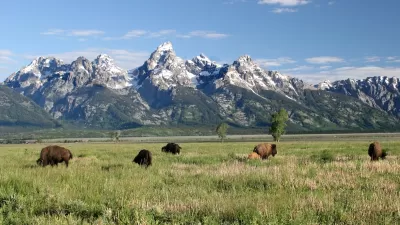An order issued late last week pushes for increased mineral extraction on federally owned public lands.

A new executive order from the Trump administration titled “Immediate Measures to Increase American Mineral Production” enables mineral extraction on federal public lands. According to an article from Rocky Mountain Community Radio by Caroline Llanes, “The order includes uranium, copper, potash, gold, and gives a new ‘National Energy Dominance Council’ broad authority to designate other minerals.”
The order also calls for streamlining the permitting process for mining and the immediate issuance of approval for some projects, encouraging federal departments to seek feedback from the mining industry on “regulatory bottlenecks” but not from local communities that would be impacted.
In addition to harm to wildlife and local ecosystems, Rachel Hamby, policy director at the Center for Western Priorities notes, “there are the well-known impacts to things like surface and groundwater and contamination of soil, and even the release of dangerous substances into the air that are gonna travel beyond the footprint of the mine or the production facility and impact nearby communities.”
Public lands across the country, especially in the West, are under threat as the new administration attempts to claw back protections for new national monuments designated by former presidents such as Chuckwalla National Monument in Southern California and Bears Ears National Monument in Utah. Now, Trump wants to end the Antiquities Act, which allows presidents to create new national monuments for historical, environmental, or cultural reasons, and increase resource extraction on protected lands.
FULL STORY: Executive order from Trump seeks to ramp up mining operations on federal public lands

Alabama: Trump Terminates Settlements for Black Communities Harmed By Raw Sewage
Trump deemed the landmark civil rights agreement “illegal DEI and environmental justice policy.”

Planetizen Federal Action Tracker
A weekly monitor of how Trump’s orders and actions are impacting planners and planning in America.

How Atlanta Built 7,000 Housing Units in 3 Years
The city’s comprehensive, neighborhood-focused housing strategy focuses on identifying properties and land that can be repurposed for housing and encouraging development in underserved neighborhoods.

In Both Crashes and Crime, Public Transportation is Far Safer than Driving
Contrary to popular assumptions, public transportation has far lower crash and crime rates than automobile travel. For safer communities, improve and encourage transit travel.

Report: Zoning Reforms Should Complement Nashville’s Ambitious Transit Plan
Without reform, restrictive zoning codes will limit the impact of the city’s planned transit expansion and could exclude some of the residents who depend on transit the most.

Judge Orders Release of Frozen IRA, IIJA Funding
The decision is a victory for environmental groups who charged that freezing funds for critical infrastructure and disaster response programs caused “real and irreparable harm” to communities.
Urban Design for Planners 1: Software Tools
This six-course series explores essential urban design concepts using open source software and equips planners with the tools they need to participate fully in the urban design process.
Planning for Universal Design
Learn the tools for implementing Universal Design in planning regulations.
Jessamine County Fiscal Court
Caltrans
Institute for Housing and Urban Development Studies (IHS)
City of Grandview
Harvard GSD Executive Education
Toledo-Lucas County Plan Commissions
Salt Lake City
NYU Wagner Graduate School of Public Service





























